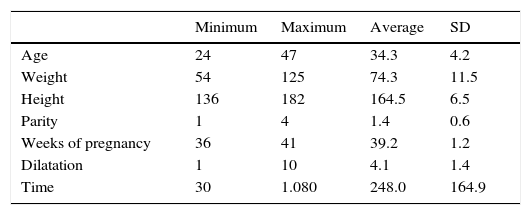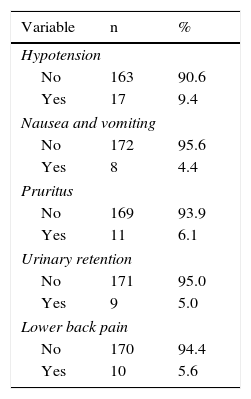Numerous studies have demonstrated the difference in the verbal rating scale with regard to obstructed labour and induced labour, so that obstructed labour and foetal macrosomia have been related to a greater sensation of pain during labour, particularly in the first stage. Even the epidural analgesia is linked to the need for instrumented or caesarean section due to foetal obstruction. The goal of the study is to analyse and evaluate the effectiveness of epidural analgesia in normal versus obstructed labour.
Patients and methodsOne hundred and eighty pregnant women were included in an observational, analytical, longitudinal and prospective study, that was performed in the Obstetrics Department of the Hospital Universitario Dexeus. All the nulliparous or multiparous over 36 weeks of pregnancy, after 3cm of cervical dilatation in spontaneous or induced labour were included. All the patients were given epidural analgesia according to protocol.
ResultsThe basic descriptive methods were used for the univariate statistical analysis of the sample and the Mann–Whitney U test was used for the comparison of means between both groups. The correlations between variables were studied by means of the Spearman coefficient of correlation. The differences regarded as statistically significant are those whose p<0.05.
ConclusionIn our population there were no statistically significant differences in the effectiveness of epidural analgesia in normal versus obstructed labour. Patients who got epidural analgesia and had obstructed labours have the same degree of verbal rating scale as patients that do not had obstructed labours (p>0.05).
Numerosos estudios han demostrado mayor puntuación en la escala verbal nominal del dolor en relación con el parto distócico y la inducción médica del parto, de manera que el parto distócico y la macrosomía foetal se han relacionado con una mayor sensación de dolor durante el parto, sobre todo en el primer estadio. Incluso la analgesia epidural se ha vinculado al parto instrumentado y a la cesárea. El objetivo del estudio fue analizar y evaluar la efectividad de la analgesia epidural en el parto distócico frente al parto eutócico.
Pacientes y métodosSe diseñó un estudio observacional, analítico, longitudinal y prospectivo, en el Área Obstétrica del Hospital Universitario Dexeus. Se incluyeron 180 gestantes. Fueron incluidas todas las nulíparas o multíparas con edad gestacional superior a 36 semanas, más allá de 3cm de dilatación cervical y en trabajo de parto espontáneo o inducido. Todas las pacientes recibieron la analgesia epidural según protocolo.
ResultadosPara el análisis estadístico univariante de la muestra se emplearon los métodos descriptivos básicos y para la comparación de medias entre 2 grupos, el test U de Mann–Whitney. Las correlaciones entre variables se estudiaron mediante el coeficiente de correlación de Spearman. Las diferencias consideradas estadísticamente significativas fueron aquellas cuya p<0,05.
ConclusiónEn nuestra población, no hubo diferencias estadísticamente significativas en la efectividad de la analgesia epidural en el parto eutócico frente al distócico. Las pacientes que recibieron la epidural que tuvieron partos distócicos presentaron la misma puntuación en la escala verbal nominal del dolor que aquellas que presentaron parto eutócico (p>0,05).











